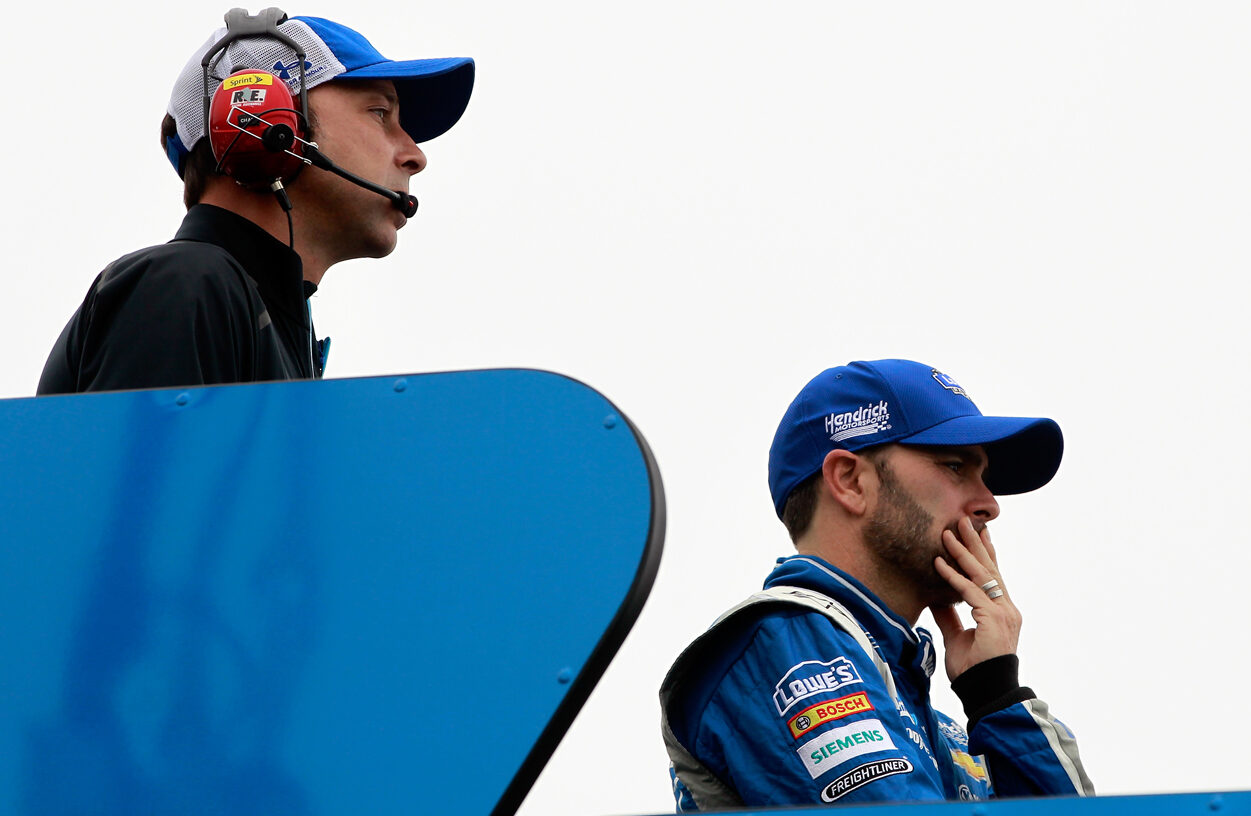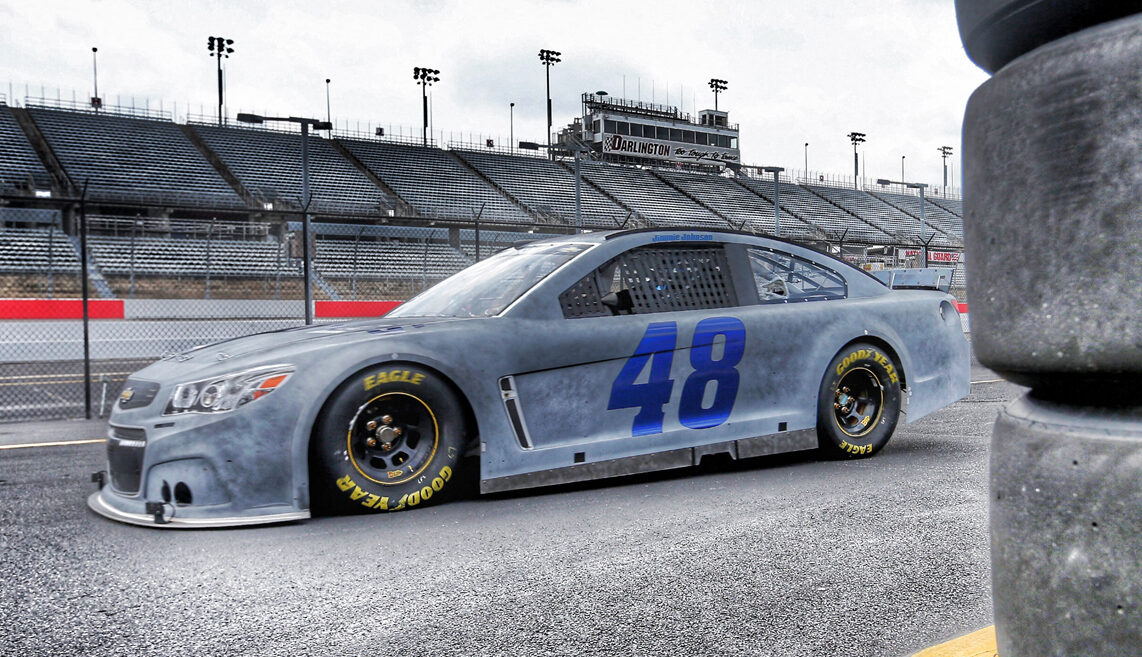Seeing Red – NBC Sports Article on Jimmie Johnson

Joe Posnanski
NBC Sports national columnist
June 3, 2015
* These are excerpts, with minor corrections made to the original text
EL CAJON, Calif. — Nobody around him believes that Jimmie Johnson is RED. It just doesn’t make any sense. Chad Knaus, Johnson’s volatile crew chief, yes, absolutely, he’s RED, he’s the very definition of RED, his photograph should
be included when explaining what RED even means. But Jimmie Johnson? RED just doesn’t make sense.
See, every single employee in Rick Hendrick’s giant Automotive Group and Motorsports Division takes a Management By Strengths profile test. Hendrick does not just believe in these tests; he incorporates them into every facet of the
business. In his dealerships, employees will wear name tags with their management color. Managers are encouraged to study the tests to help people work better together. It’s a big deal for Rick Hendrick, something he believes is
a big part of his company’s success.
Here we are, 14 years after [Jimmie Johnson] burst onto the NASCAR scene by winning the pole at his first Daytona 500, and he’s piling up numbers that stagger the mind. Heck, the numbers stagger HIS OWN mind. He has won 74 races,
which is two shy of that giant shadow of Dale Earnhardt. “Beyond my wildest dreams,” he says.
And how has he done it? How has Jimmie Johnson, described first and foremost as a “nice guy” by everyone who has met him, closed in on Dale Earnhardt, the Intimidator, the Man in Black, the reddest RED who ever stepped behind the
wheel of a stock car?
“Ask him to tell you the Lowe’s story,” says Julie Cunningham, the marketing director for sports and partnerships at Lowe’s.
[Working with Chad] “Jimmie needs to be candid and get to the point.”
[Working with Jimmie] “Chad needs to give some space and respect Jimmie’s privacy.”
~ Managements by Strengths suggestions for how Jimmie Johnson and Chad Knaus should work together
In 2002, Hendrick and Gordon decided to do something unprecedented; they teamed up to create a new race team. The team would be given the same car and setup as Gordon’s championship team. It was basically like founding an NFL expansion
franchise with players and coaches from the previous year’s Super Bowl winner. Gordon and Hendrick decided to give this golden ticket to Jimmie Johnson.
Johnson had already turned 26 years old. He had been struggling for years to get this chance and he had a thorough understanding of the opportunity he was being given. He went all out. He became a sponsor’s dream in the friendly
way he handled every appearance and schmoozed with business people. He became a favorite of reporters by the way he tried to thoughtfully answer every question.
And as a driver, well, he was just about ideal there too. Where other drivers tend to be ferocious in their demands — they insist that the car feel EXACTLY right, after all, it’s their neck on the line out there on the track — Johnson
drove the car with few complaints. He did not try to impose his will. Knaus knew how to set up fast cars, and Johnson would find ways to drive them even if he did not always feel comfortable behind the wheel.

“You are confident, frank and can be outspoken.”
~ From Jimmie Johnson’s Management By Strengths profile
When he finished fifth in the Cup in 2005, there were questions: “What’s wrong with Jimmie Johnson?” And: “Can he win the big one?” Some thought him too conservative a driver. Some thought him too buttoned up. Most, though, thought
his ability to win the championship came down to a simple thing.
“I would read all these stories,” he says, “that said that I was too nice a guy. I thought, ‘Really? I’m too nice? You don’t even know me.’”
“Do you mean you’re not a nice guy?” you ask him.
He shrugs. “Not on the race track,” he says.
Jimmie Johnson and Chad Knaus have similar profiles, which is weird if you have ever met them. They seem very different. Knaus seems much more intense. Johnson seems much more friendly. Knaus seems much more of a yeller. Johnson
seems much more of a listener. But the profile says that both are extremely fast-paced people who like being direct. Both prefer working outside of a structured environment, meaning they want their independence.
The one difference in their profiles is that Knaus is very much an extrovert, meaning he loves to talk and loves to work with a team. Johnson, meanwhile, scored as something of an introvert, which might shock anyone who has seen
the natural way he is around people.
Johnson says it should not shock people; his natural inclination is to be introverted. He likes solitary activities. His wife, Chandra, says there are times he just needs to be alone. This is fine when he’s with family, but as a
race car driver, his introverted ways directly clash with his hunger to, yes, be in control and make decisions. For those first few years, he and Knaus were at each other’s throats and Johnson did not fully understand why. Rick Hendrick,
being the happy and dreamy BLUE person that he is, famously called them into a meeting. On the table, there was milk and cookies and Mickey Mouse plates.
“Boys,” Hendrick said, “it’s time we start talking to each other.”

That’s when Johnson finally let loose with some of his frustrations. He wanted to be heard. He wanted to feel empowered to say, “No, I don’t feel comfortable in this car. I want changes.” Knaus also let loose. He wanted Johnson to
push himself harder and challenge the other drivers and race with a little bit more fury.
Both men say that the meeting was a turning point in their relationship and friendship. They are more like brothers than teammates now. “It makes me laugh when people freak out because we yell at each other on the radio,” Johnson
says. “We’re such good friends now that we can say anything to each other.”
“You are intolerant of mediocrity,”
~ From Jimmie Johnson’s Management By Strengths profile
OK, here’s the Lowe’s story: When Jimmie Johnson was 25, he was called to a meeting at Hendrick Motorsports. When he got there, he found Rick Hendrick and former Lowe’s Chief Executive Officer Bob Tillman talking. They were having
a good time, talking about old cars, when they suddenly went quiet. Johnson was told to take a seat. And Bob Tillman began.
“Son,” he said, with an edge in his voice, “I’ve been here all day listening to what this guy, Hendrick, has to say about this race team and how good it is.”
Johnson shifted uncomfortably in his chair. He tried to keep a straight face. At that point, he had not raced in a single Sprint Cup race. He had not won a single Busch race.
“Listen,” Tillman continued. “I’ve got a group of three hundred thousand employees that have not had a winning driver. The only reason I’m here is to know if I can have a winning team and a winning driver.”
And then he turned his glare on to Johnson. The room felt impossibly silent, as if even the room’s oxygen had stopped moving.
“So what I want to know Jimmie Johnson,” he said, “is this: Can you win a race for me?”
With that Tillman stopped talking and he looked hard at Johnson. Hendrick looked hard at Johnson. Even 15 years later, when Johnson relives the scene as he drives around his hometown, he clenches up a little bit. It was, in so many
ways, the pivotal moment of his racing life. And in that moment, the RED of Jimmie Johnson’s profile pushed to the surface, and he stared right back at the CEO of Lowe’s and said with a certainty that shocked everyone: “Yes. Absolutely.
I will win races for you.”
“Did you believe it?” I ask Jimmie Johnson now. He is almost 40, winner of 74 races and six Cup Championships. He has won almost $150 million in prize money. He stares at the road where he grew up, and he grabs the steering wheel
a little tighter, and gives me a hard look that must be something like he gave that day. His eyes are RED.
“Yeah,” he says. “You don’t chase your dreams without believing.”
The entire article can be found on the NBC Sports website:http://sportsworld.nbcsports.com/jimmie-johnson-driven-to-win/ *

